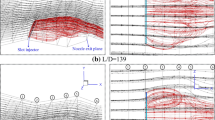Abstract
Dual throat nozzle (DTN) is fast becoming a popular technique for thrust vectoring. The DTN is designed with two throats, an upstream minimum and a downstream minimum at the nozzle exit, with a cavity in between the upstream throat and exit. In the present study, a computational work has been carried out to analyze the performance of a dual throat nozzle at various mass flow rates of secondary flow and nozzle pressure ratios (NPR). Two-dimensional, steady, compressible Navier-Stokes equations were solved using a fully implicit finite volume scheme. The present computational results were validated with available experimental data. Based on the present results, the control effectiveness of thrust-vectoring is discussed in terms of the thrust coefficient and the coefficient of discharge.
Similar content being viewed by others
References
Bursey, R. and Dickinson, R.: Flight Test Results of the F-15 SMTD Thrust Vectoring/Thrust Reversing Exhaust Nozzle, AIAA Paper, 90-1906, Orlando, FL, USA, (1990).
Regeniee, V., Gatlin, D., Kempel, R. and Matheny, N.: The F-18 High Alpha Research Vehicle: A High Angle-of-Attack Testbed Aircraft, NASA TM, 104253, Springfield, VA, USA, (1992).
Jung, S. J., Kim, H. D., Ahn, J. M. and Jung, D. H.: Study of the Thrust Vector Control Using a Secondary Flow Injection, Proc. of The Korean Society of Propulsion Engineers(KSPE) Spring Annual Meeting, Seoul, Korea, pp.14–15, (2002).
Green, C. J. and Mc Cullough, M. Jr.: Liquid Injection Thrust Vector Control, AIAA Journal, Vol.1, No.3, pp.573–578, (1963).
Jung, S. J., Kumar, V. R. S. and Kim, H. D.: A Study of Thrust-Vectoring Nozzle Flow Using Coflow-Counter-flow Concept, Proc. of The Korean Society of Mechanical Engineers(KSME) Fall Conference, Muju, Korea, pp.592–597, (2003).
Flamm, J. D., Deere, K. A., Mason, M. L., Berrier, B. L. and Johnson, S. K.: Experimental Study of an Axisymmetric Dual Throat Fluidic Thrust Vectoring Nozzle for Supersonic Aircraft Application, AIAA Paper, 2007-5084, Hampton, VA, USA, (2007).
Shin, C. S., Kim, H. D.: A Study on the Supersonic Flow Characteristics Through a Dual Throat Nozzle, Journal of The Korean Society of Propulsion Engineers(KSPE), (2010)(to be published).
Berrier, Bobby L., Leavitt, Laurence D. and Bangert, Linda S.: Operating Characteristics of the Multiple Critical Venturi System and Secondary Calibration Nozzles Used for Weight-Flow Measurements in the Langley 16-Foot Transonic Tunnel, NASA TM-86405, Washington, D.C., USA, (1985).
Giuliano, V. J. and Wing, David J.: Static Investigation of a Fixed-Aperture Exhaust Nozzle Employing Fluidic Injection for Multiaxis Thrust Vector Control, AIAA Paper, 97-3149, Hampton, VA, USA, (1997).
Yagle, P. J., Miller, D. N., Ginn, K. B. and Hamstra, J. W.: Demonstration of Fluidic Throat Skewing for Thrust Vectoring in Structurally Fixed Nozzles, 2000-GT-0013, Fort Worth, TX, USA, (2000).
Abdol-Hamid, K., Pao, S., Massey, S. and Elmiligui, A.: Temperature Corrected Turbulence Model for High Temperature Jet Flow, ASME Journal of Fluids Engineering, Vol.126, No.5, (2004).
Elmiligui, A., Abdol-Hamid, K. and Hunter, C.: Numerical Investigation of Flow in an Over-expanded Nozzle with Porous Surfaces, AIAA Paper, 2005-4159, Hampton, VA, USA, July, (2005).
Author information
Authors and Affiliations
Rights and permissions
About this article
Cite this article
Shin, C.S., Kim, H.D., Setoguchi, T. et al. A computational study of thrust vectoring control using dual throat nozzle. J. Therm. Sci. 19, 486–490 (2010). https://doi.org/10.1007/s11630-010-0413-x
Received:
Published:
Issue Date:
DOI: https://doi.org/10.1007/s11630-010-0413-x




